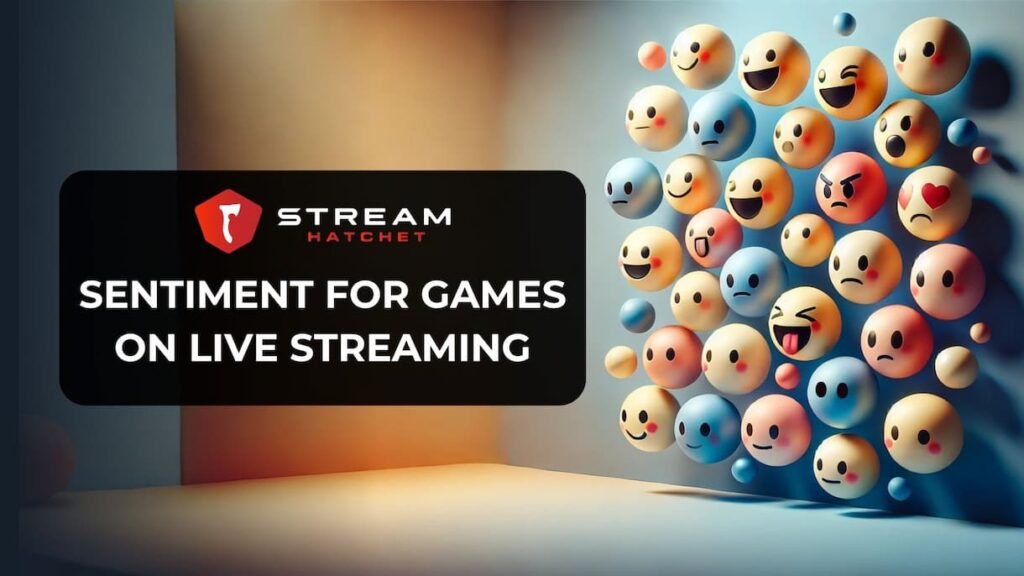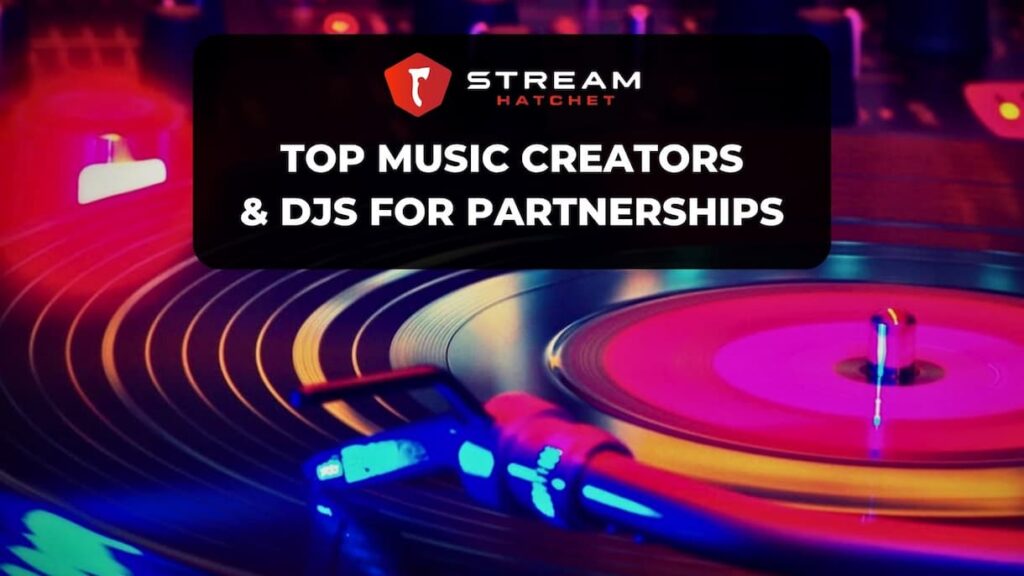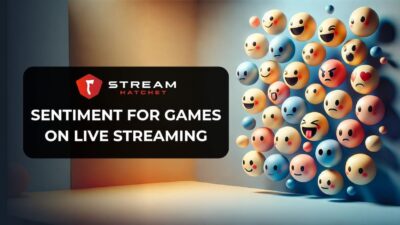Game publishers need more data to figure out how potential buyers are feeling about their upcoming game launches. That’s why we’ve been diving into the link between common game discovery metrics and live streaming popularity, like Steam Wishlists and Perennial Sellers.
Continuing in our quest to demystify the link between promotion and conversions, in this article we’re looking at how chat sentiment on live-streaming platforms can act as a predictor of success for new games. Twitch audiences love to follow every single announcement leading up to a game’s release, and to dissect the game once it comes out. So we’re going to go in-depth on some examples of best-selling games and pick apart their sentiment both pre- and post-release.

TL;DR Takeaways by Stream Hatchet:
- Fans of new releases drive up chat sentiment on game-tagged streams, but this echo chamber doesn’t necessarily reflect broader live-streaming opinion
- The biggest reason sentiment drops after release? Poor optimization and technical issues: A reputation that’s hard to shake
- Lesser-known games can actually see higher sentiment outside of their own streams, as positive word-of-mouth spreads to new streamers
Best-selling Games: How Sentiment Changes Pre- Vs. Post-Release
Before we dive into the analysis itself, it’s worth explaining a little bit about our method, given the tricky nature of measuring sentiment. A simplified step-by-step explanation follows:
- We first generated and vetted a list of “positive” and “negative” keywords often used by chatters to describe games, referencing their graphics, gameplay, community, or performance.
- We then looked for messages on Twitch that contained any of these keywords.
- From this, we created two different types of sentiment ratios (Positive:Negative messages):
- “Off-stream” sentiment includes all messages containing the sampled game’s title anywhere on Twitch.
- “On-stream” sentiment includes all messages sent on any stream of the sampled game, regardless of whether the message contains the sampled game’s title.
_
Using these two types of sentiment, we looked at four best-selling games from the last few years. We examined their pre- and post-release periods to see how sentiment shifted following the games’ launches, and we also looked at the difference between On-stream and “Total” sentiment (Off-stream + On-stream) post-release to see how chatters actively watching the game differ in opinion from chatters on other Twitch streams. The games we looked at include:
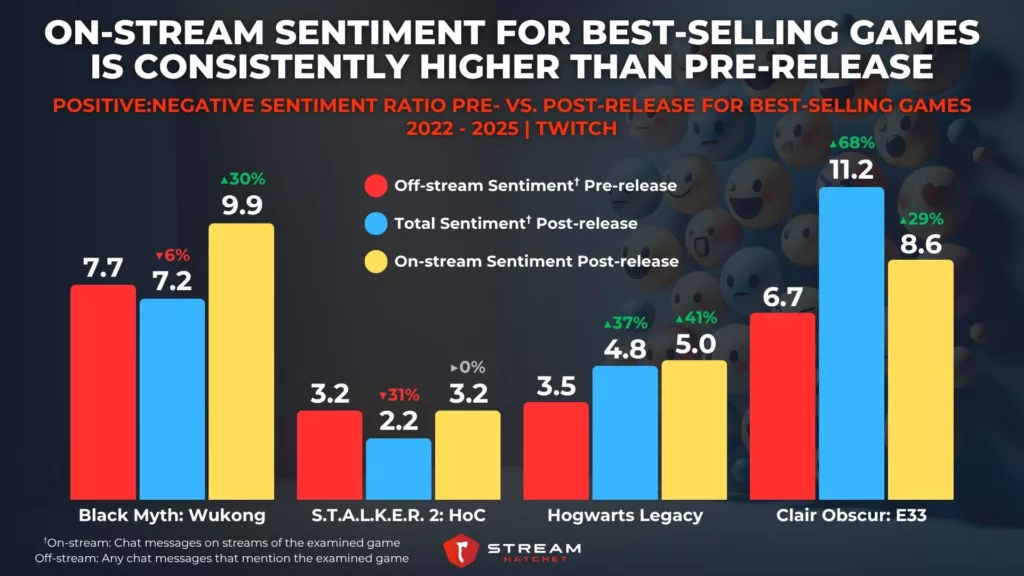
Below, we’ll dive into the reasons we chose these four games specifically, but first let’s take a look at some general trends between their Off-stream and On-stream sentiments pre- and post-release.
As one might expect, On-stream sentiment tends to be the highest across every game. This reflects the fact that people watching game streams are more likely to be fans of said game, and therefore have more positive things to say about it. However, Clair Obscur bucks this trend, seeing far higher Total sentiment post-release (blue) than On-stream sentiment (yellow). In the section on Clair Obscur below, we’ll explore why people not even watching the game might actually have more positive things to say about it on streaming.
We can also see that, generally, sentiment for a game increases following release when looking at game streams specifically. In 3 of the 4 games examined, the increase in sentiment from Off-stream pre-release (red) to On-stream post-release (yellow) was roughly 35%. The exception here was S.T.A.L.K.E.R. 2, which as we’ll see in a moment suffered criticism in the early days of its launch.
Finally, note that S.T.A.L.K.E.R. 2 and Hogwarts Legacy have generally lower sentiment across all three categories: This will be explored later…
Black Myth: Wukong: An Awaited Game Praised at Launch

Black Myth: Wukong is a classic success story for an unestablished IP. The game was highly anticipated thanks to its impressive visuals and the timing of its release just when Souls-likes were enjoying their peak popularity. Thanks to this, Black Myth: Wukong saw a few hundred chat mentions per week leading up to its release with high positive sentiment. When release week hit, chat mentions soared… but the Total sentiment dropped (remember that’s Off-stream + On-stream sentiment).
This is surprising: Black Myth: Wukong was generally well-received by critics and commercially successful. So why the drop? This may be a matter of expectations: While Black Myth: Wukong rode its Souls-like label to success, the game is really more of a boss rush brawler. Failing to deliver on this front appears to have split the game’s potential audience: Off-stream sentiment dropped as people criticized the misleading word-of-mouth marketing, but On-stream sentiment rose among fans who loved Black Myth: Wukong’s gameplay regardless. Alternatively, it may simply be that the amount of hype was too much to live up to, and that fall in sentiment was inevitable from the game’s pre-release highs.
Note: Sentiment grows more erratic when chat mentions are lower, like in the On-stream sentiment for Black Myth: Wukong. This is a product of higher variability from a lower sample size and, as such, seemingly sharp peaks or troughs should be taken with a grain of salt.
S.T.A.L.K.E.R. 2: Heart of Chornobyl: A Hyped Game Criticized on Launch
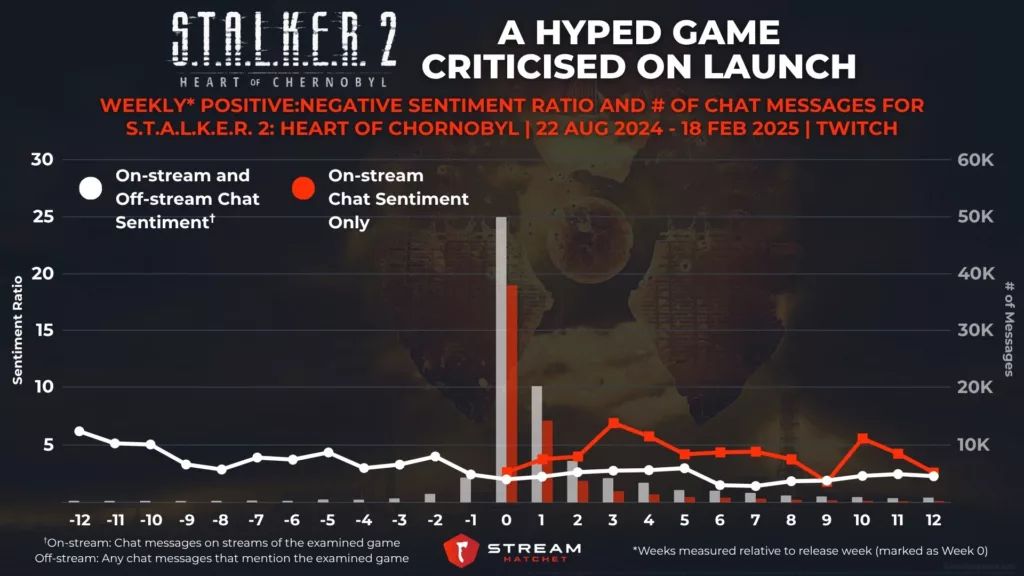
S.T.A.L.K.E.R. 2 was also a hyped game, particularly on live-streaming where the mixture of FPS and Survival Horror gameplay is like catnip to viewers. As a sequel, the game also had a leg up on some of the other titles examined here. However, when you compare the sentiment for S.T.A.L.K.E.R. 2 to Black Myth: Wukong, there are some warning signs: Off-stream sentiment pre-release is less than half that of Black Myth: Wukong, suggesting that live-streaming support for the title wasn’t as robust.
This wavering support from dedicated fans took a hit when S.T.A.L.K.E.R. 2 launched with significant performance issues. Total sentiment post-release dropped off, settling at a ratio of around 2:1 positive:negative messages per week as people complained about the game’s bugs on other streams. Despite all these issues though, the hardcore fanbase stuck with the game and On-stream sentiment was around double that of Total sentiment post-release. Being able to access S.T.A.L.K.E.R. 2 via Xbox’s Game Pass allowed the developers to keep the game alive, make updates, and drive significant sales, but the battle for live-streaming popularity was, unfortunately, already lost.
Hogwarts Legacy: A Controversial Game Redeemed upon Launch
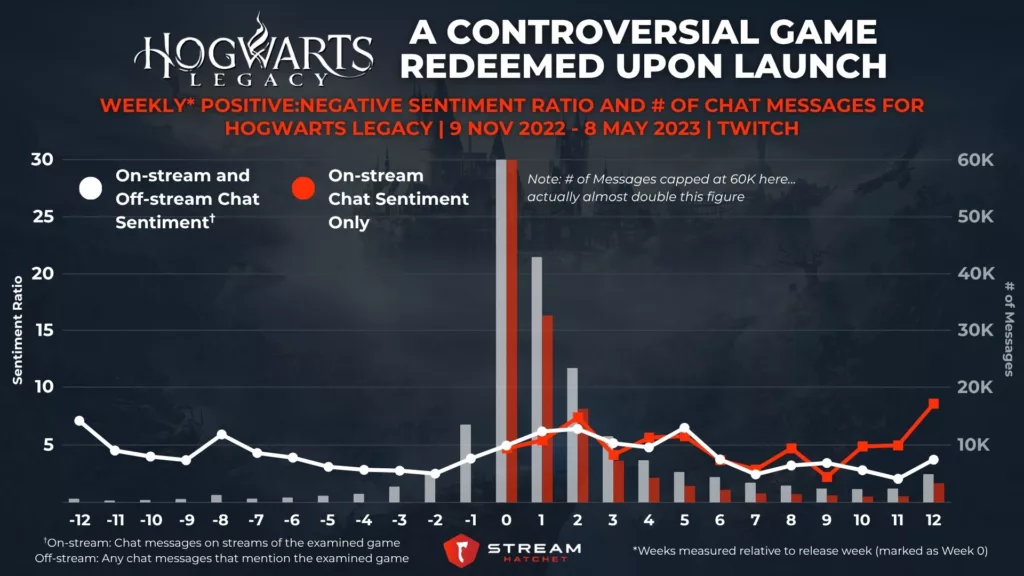
Hogwarts Legacy had the opposite issue to S.T.A.L.K.E.R. 2: It faced an uphill battle prior to launch thanks to the J.K. Rowling controversy surrounding the Wizarding World (Harry Potter) IP. There were calls to boycott the game from progressives in the gaming community, and this debate thrived on live-streaming platforms. Naturally then, the Off-stream sentiment for Hogwarts Legacy pre-release was relatively low, dipping to a ratio of just 2.5:1 a couple weeks prior to release. However, across the entire period examined, the controversy drove roughly double the chat mentions of any of the other games examined here per week: Perhaps an example that any publicity is good publicity.
When Hogwarts Legacy released and impressed the broader gaming community, sentiment got a boost. Total sentiment more than doubled, and On-stream sentiment matched this at a ratio of around 5:1 over the game’s first few weeks. Finally, the release of the polished Xbox and PlayStation versions of the game in May of 2023 saw another bump in sentiment. So how did Hogwarts Legacy right the ship here? Simple: It delivered what people expected. Hogwarts Legacy allowed players to inhabit the Wizarding World with their own personalized wizard – a dream for fans of the original IP. Compare this to the mismatched expectations of Black Myth: Wukong which resulted in a dip in sentiment post-release.
Clair Obscur: Expedition 33: An Unknown Game Discovered at Launch

Clair Obscur is a fitting name for a title that was so little-known that, even 3 months before its release, there were only a handful of chat mentions on Twitch. However, 2 months before launch we see chat mentions start to rise and the initial reception was overwhelmingly positive with a peak sentiment ratio of 21:1 (that’s on par with Black Myth: Wukong’s pre-release sentiment). This early encouragement stemmed from a flood of preview content and the surprising announcement that Clair Obscur would be adapted into a feature film (despite it not even being out yet!).
This pre-release interest translated into post-release demand for the title. Total sentiment for Clair Obscur doubled upon release and floated at a ratio of around 11:1 for the first 3 months. What’s curious though is that the On-stream sentiment for the game was actually slightly lower than the Total sentiment – why? It may be that because Clair Obscur was a lesser-known game, fans took to other streamers’ channels to spread the word about how much they loved it. Surprise indie hits are often the topic of discussion for streamers looking to choose which game they’ll play next. In essence, the sheer quality of Clair Obscur had viewers singing its praises on Twitch.

Looking at all four games together makes it easier to compare the effect of their differing pre-release hype and post-release receptions. We have:
- Black Myth: Wukong: High pre-release opinion, high post-release praise
- S.T.A.L.K.E.R. 2: High pre-release opinion, low post-release praise
- Hogwarts Legacy: Low pre-release opinion, high post-release praise
- Clair Obscur: Unknown pre-release opinion, high post-release praise
_
Although all of these games sold well, it’s interesting to see how vastly their sentiment curves differ. Black Myth: Wukong and Clair Obscur both had very high sentiment pre-release which mostly persisted post-release. But lower Total sentiment doesn’t necessarily mean a game won’t sell: S.T.A.L.K.E.R. 2 and Hogwarts Legacy both had significantly lower sentiment than the other games, but still sold millions of copies.
The difference? S.T.A.L.K.E.R. 2 and Hogwarts Legacy are based on pre-existing IPs. Both games have an in-built audience they can rely on to try the game upon release. Where these games differ is in how they capitalized upon this in-built audience: Hogwarts Legacy saw a jump in sentiment thanks to quality gameplay and well-managed player expectations, which drove long-term sales (11.3M copies according to Gamalytic). S.T.A.L.K.E.R. 2 did sell well, yes, but only initially by converting its already loyal audience from the original title (1.8M copies). The continuing drop in Total sentiment reflected a poor first impression on live-streaming platforms that was never fully corrected despite the game’s significant post-launch improvements.
_
As always, there are so many confounding factors in these examples to draw definitive conclusions, from differences in genre to release date to target audience. But in general, live-streaming sentiment as measured here seems to track well with the sentiment found among Steam reviews and other social media platforms. At the least, live-streaming sentiment is another way of confirming sentiment signal from other sources.
For indie games though, this live-streaming sentiment signal can be even more powerful. These games depend upon social chatter to find their audiences, and so a positive sentiment on live-streaming pre-release (as seen with Black Myth: Wukong and Clair Obscur) is a great sign that a game will be received well post-release too.
Now that we have a good gauge of what sentiment ratios are standard and how these sentiment scores change after release, we can go further and explore the correlation between sales and streaming sentiment in a future analysis. To hear when we release the next article, and to keep up to date with other trends shaping game discovery on live streaming, follow Stream Hatchet and receive exclusive newsletter-only content:

